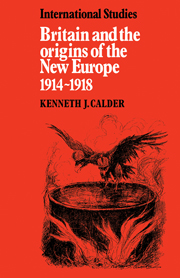Book contents
- Frontmatter
- Contents
- Dedication
- Acknowledgements
- Map
- Introduction
- 1 The initial contact
- 2 Yugoslavia in the Balkan negotiations, 1914–15
- 3 Espionage and propaganda, 1914–16
- 4 War aims, 1916
- 5 Britain and Austria-Hungary, 1917–18
- 6 The recognition of the Polish National Committee, 1917
- 7 Commitment by implication, 1918
- Conclusion
- Notes
- Bibliography
- Index
5 - Britain and Austria-Hungary, 1917–18
Published online by Cambridge University Press: 07 October 2011
- Frontmatter
- Contents
- Dedication
- Acknowledgements
- Map
- Introduction
- 1 The initial contact
- 2 Yugoslavia in the Balkan negotiations, 1914–15
- 3 Espionage and propaganda, 1914–16
- 4 War aims, 1916
- 5 Britain and Austria-Hungary, 1917–18
- 6 The recognition of the Polish National Committee, 1917
- 7 Commitment by implication, 1918
- Conclusion
- Notes
- Bibliography
- Index
Summary
In January 1917 the British government was committed neither to the preservation nor to the destruction of the Habsburg monarchy. To a government involved in a war for survival, and concerned with the immediate problems of its own preservation, the future of Austria-Hungary was an issue of at most secondary importance. The government was not totally indifferent to the future of eastern Europe but its aims in that area were of a general nature, and might be achieved by any one of a number of solutions proposed for the final settlement. Any solution which did not increase the military potential of the Central powers and which was conducive to peace and stability was acceptable. It could be argued that these aims would be satisfied by the preservation of the Habsburg monarchy, by the absolute application of national self-determination or by any one of a number of compromises between these two which in practice would mean self-determination for some nationalities but not others. While the relative merits of each solution were debatable, conclusive evidence did not and could not exist by which the policy-makers could predict which solution would best satisfy their general aims in eastern Europe. The solutions could be tested only by application. While the war was in progress and the future of Europe uncertain, there was no overwhelming need for the government to choose the programme for eastern Europe that it would favour during peace negotiations.
- Type
- Chapter
- Information
- Britain and the Origins of the New Europe 1914–1918 , pp. 108 - 144Publisher: Cambridge University PressPrint publication year: 1976



